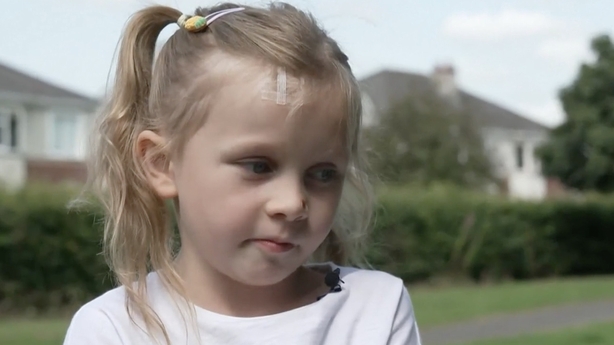Figures from An Garda Síochána show that for the first six months of this year, collisions involving scooters rose from 123 to 174, a 41% increase compared to the same period last year. The number of fatal and serious injury collisions rose from 18 to 39, a 117% jump.
Prime Time's Paul Murphy has been speaking to people involved in collisions, and examining the policies relating to e-scooters.
Last week, seven-year-old Kate Heffernan was walking with her grandmother along the Grand Canal in Dublin. An e-scooter came from behind and hit her at speed as the driver tried to cut between Kate and her grandmother, Kate's mother Anne Marie told RTÉ's Prime Time.
"She was like a rag doll thrown up into the air," she said. Kate ended up with multiple cuts on her legs and body and was admitted to hospital with a gash on her head. "The priority was stopping her bleeding, getting stitches on her forehead," her mother said.
Little Kate says the accident was the most frightening thing to ever to happen to her.
"I went down my head," she said, "there was a lot of blood from my knee and my head and my nose."

The e-scooter driver stopped, but only momentarily. "He did say, 'I'm sorry, I'm sorry,’" said Anne Marie, "and a second later," he was gone.
"It was like a hit-and-run, he just took off. I don't know whether he panicked or what."
Anne Marie says she is "just thankful" that the injury to her only child wasn't worse. "She's very petite, she's only turned seven. That impact on her head could have been worse, but she's still going to be left with a permanent scar."
Kate said she wants the man who hit her to stop speeding "so he can't run more people down."
Her mother worries that it will shake her confidence. "She's already said she doesn't want to walk [along] the canal again. "She's looking around and is a bit anxious that there might be a scooter coming behind," she said.

Drivers as well as pedestrians can be vulnerable.
"An e-scooter is probably inherently not a very safe vehicle," said Dr John Legge, a consultant in emergency medicine at St Vincent’s University Hospital in Dublin. "It's got very small wheels" so is prone to slippage on an uneven surface, he said, adding that a driver's centre of gravity is high because they are standing.
In contrast, "if you're on a bicycle, for example, the wheels are much bigger," he points out. "You've got a lower centre of gravity because you're lower down on it and you're also more aware of the speed you're going because you're generating the speed yourself."
Until recently, e-scooters were in a legal grey zone, but in May a law to regulate them was introduced.
Under the new law, riders must be at least 16 years of age. They are not obliged to have insurance or wear a helmet or register the e-scooter. They must obey a 20km/h speed limit and they must follow the rules of the road that apply to cyclists such as having front and back lights outside of daylight hours and staying off footpaths.
Many regular pedestrians are road users would say the latter prohibition is widely ignored, as former international athlete and choir director Mary Amond O'Brien experienced to her painful cost.
The Carlow woman was hit on a footpath last October as she came out of a pharmacy in the town.
She "had only taken one or two steps" out of the shop when an e-scooter crashed into the right side of her body.
"I was thrown a little bit along the path by the impact of the scooter. I was a bit disorientated. I didn’t know where I was. And then I realised when I tried to talk that I couldn't really talk very much because… one of my front teeth was displaced downwards."

She also had other injuries, including to her upper lip and her chin. "There was quite a lot of blood," she said. Nine months after the accident, she is still getting dental treatment for her injury.
Scooters are sold with a 20km/ph limiter, but this is easily overridden, said Marco Sants, the owner of Lifty Electric Scooters in Dublin.
Some riders are "hacking their scooter with third-party software, making it faster," said Mr Sants, adding that videos showing how to do the hacking are readily available online.
An Garda Síochána told Prime Time that it "is not in a position to provide detailed statistical information on the enforcement of e-scooter regulations at this early stage."
The Garda Press Office provided a quote from a recent statement by Commissioner Drew Harris.
"In respect of the new legislation, obviously there is an information programme and we are part of that. Our approach to that in the first instance will be to engage and educate," he told an Oireachtas committee in May.
The legal certainty provided by the new law has boosted sales significantly in at least one e-scooter retailer. Sales have "gone up by 200%," at Mr Sants shop.
"Before, they were kind of in a grey area, they weren't really legal. [E-scooter drivers] know now they can be out and about without being worried that [their scooter] is going to be taken away by the cops," he said.
However, not all scooters are now legal. Those with engines more powerful than 400 watts remain illegal to use on public roads. Prior to the new law, many people bought those more powerful models. Now if they use them on a public road, they risk prosecution.
Some people have spent up to €10,000 on powerful e-scooters that are now explicitly illegal, Mr Sants said. "What are they supposed to do with those scooters?" he asked. "Are they supposed to just throw away their scooters?"
He believes that the State should introduce "…another category like they have in France, a moped category for e-scooters and allow those users to use it with a license, with insurance and so on."






